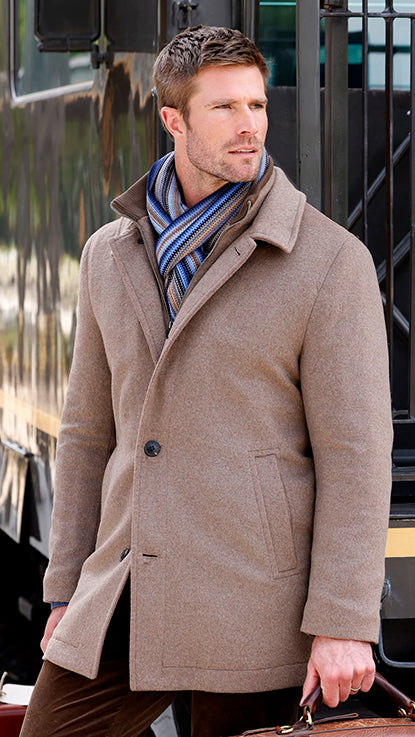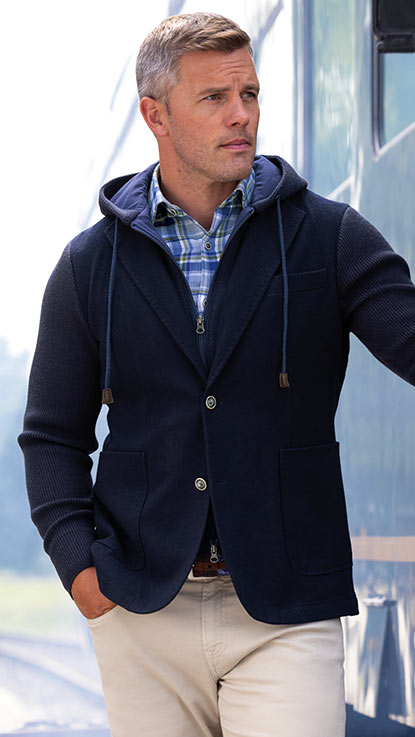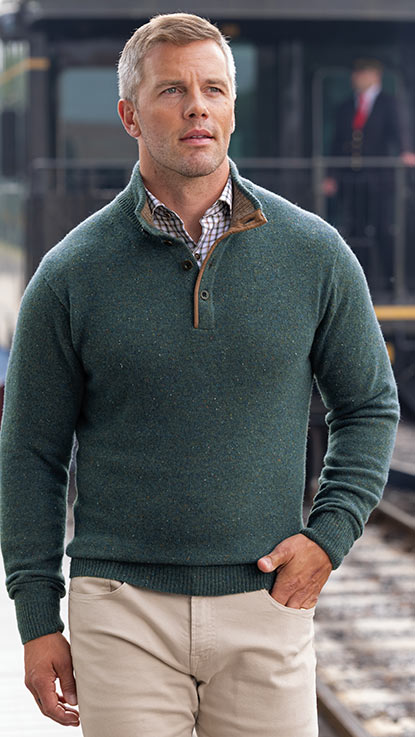
I wanted to start off the Westport Blog by giving our readers an overview on how to evaluate the overall fit of their casual clothing. Why start with casual clothing? Menswear in America, and around the world in general, is skewing more and more casual in modern times. A large majority of the clothing purchases most men will make in their lifetimes will be for what is considered “casualwear.”
Proper fit for tailored clothing is just as important, but is very measurement-driven and can become quite detailed. If you’re looking for a guide on how tailored clothing should fit, I’ll cover it in a later article. This will cover some basic fit principles, and how to evaluate proper fit for yourself. It will help you when buying tailored clothing, but will only act as a starting point.
1. Understand how clothes should fit men in the first place – especially if you’re big and tall.
Every menswear blog on the internet talks about the importance of fit in men’s clothing. It’s probably one of the most important factors that determines how your clothes and overall style are perceived by others. It’s even more of a deciding factor in regards to how a garment looks on the body than its price tag or quality alone.
Why do I say this? Even if you were to buy a basic, $5 white tee from any discount store in your correct size, it will always look better on you than an expensive, high-end tee from your local department store that you bought a size too big or small. The expensive tee may be of higher quality, it might hold up better in the wash and last you a longer time - but it still won’t look good on you if it doesn’t fit right. The great irony is that it doesn’t matter if you’ve spent thousands of dollars on the best clothes - they’ll still look bad on you if the sizing is off. Your “correct size” can be a bit tricky to get a feel for at first. But if you do want to spend the money and look great in your clothes - and maybe receive some nice compliments after it’s all said and done - there are some things you should understand about how men’s clothes should fit in the first place.
Many men buy clothes that are too big on them: button-ups, tees, dress clothing, pants, everything. Whatever it is, if it’s too big it will fold in over itself and hang off you while you’re wearing it, making you look shapeless and disheveled. Unless you want to look like your closet is made entirely of hand-me-downs, this isn’t a great look. The loose cut of the fabric may be comfortable, but it almost always winds up looking sloppy.
Big and tall men should be especially mindful of this. One of the reasons our company exists in the first place is because these guys have had such a tough time finding clothes that fit! However, too often these men will buy clothes that are way too big because they’re used to everything being too small on them. If you’re big or tall, clothes that are too large can actually accentuate your stature in all of the wrong ways. If you’re one of these gentlemen, you’ll want garments that are in the right proportions relative to your size, so that they look structured and frame your body with clean lines. This makes you look well put together and neat.
On the other hand, your clothes shouldn’t be so tight that you can see the outlines of your body. This isn’t as big of a problem for most guys, but is worth mentioning anyway. If you look in the mirror and see that your tee is accentuating parts of your body you didn’t realize you had, it’s too small. This is not a great look if you’re on the bigger side. It’s doesn’t work well even if you’re in great shape: the tightness is restricting and uncomfortable. Who wants to walk around unable to move their arms, or sit down and have their thighs busting the seams of their jeans?
That said, modern fashion is very slim-fit oriented. A large percentage of our customers are tall and skinny, or athletic. There are times when clothes cut in a slim-fit can properly frame these physiques. It won’t look good on everyone though, and that’s totally fine. Everyone can look great in their clothes as long as they wear what works for them. It’s one of those situations where you can depart from the dogmas of the fashion industry. If you don’t like your clothes too slim, go for a regular fit. Just remember that your clothes should frame you in a way that creates a clean general outline of your body. This gives you the best balance of comfort and sharp looks, and it applies to guys of all heights and sizes.
2. Know your basic measurements and use a size chart as a starting point.
Now that we have a good idea of the end result we are looking for, we can move into what to actually do to achieve it. The first thing to do is to find your basic measurements: chest, neck, sleeve, waist, and inseam. If you don’t know, just go to a tailor and have them measure you. A chest measurement is used to find your size in tops such as sweaters, casual button-ups, and tees. If you’re about 6’ 2” or taller, or just need extra length in the body and sleeves, get a tall size. Dress shirts require a neck and sleeve measurement. Pants use waist sizes and inseams. This is a good start for casualwear, but as I mentioned before, you’ll need a few other measurements if you’re buying tailored clothing.
Most retailers will provide you with a size chart that represents a healthy average of how most brands they carry will fit. We here at Westport have a chart specifically for big and tall sizing. Keep in mind, though, that every brand has its own specs. Some brands run bigger or smaller, so you may need to go up or down a size as necessary. Also, keep in mind that many modern brands offer a variety of fits in the same type of garment. Pants could come in a relaxed, straight, or slim-fit. Shirts and sweaters can be a regular cut or a slim-fit, etc.
As you would expect, proper garment sizing is the most important consideration when it comes to big and tall menswear. As part of the buying team for Westport, I’ve seen quite a few clothing lines or individual pieces that worked great aesthetically, but didn’t make it into our catalog because of sizing issues. Other times the fit is spot-on, but the merchandise itself is simply not very compelling from a price or style perspective.
This is why it made sense for us to develop our own lines with Westport 1989 and our more recent Westport Black premier luxury collection. Here we can craft our own set of specs based on actual customer feedback and experience. We can also use our 28 years of menswear experience to select the fabrics, trims, and silhouettes that we know our customers will love, as well as test out a creative new style from time to time.
3. Always try it on in the fitting room and look at a few key details.
So you know your measurements and have looked at a size chart. You see an item you like at the store and have a size or two picked out that you think might work. Now you’ll have to do something that most guys hate doing: trying it on in the fitting room. Whatever you do, don’t just take a guess. Don’t take the garment, unfold it, and hold it up to your body to “see if it’ll fit.” That doesn’t tell you anything and seldom works. You have to try it on. Yes, it does take more time. However, if you’re spending the money on nice clothes, save yourself the hassle of taking the item home, trying it on, and only then realizing that it doesn’t actually fit well. Then you’re going to have to go to the store and return it, or mail it back to the company, and you’ve wasted a lot of time. If you’re shopping for clothes online, trying them on is not possible. That’s why knowing your measurements, like I mentioned before, is so helpful. In this case, pretty much all of us have to use the size charts that the online retailer provides, take our best guess as to what size we need, and try the clothes on when they arrive. When shopping online, I personally stick to brands I’ve tried and that fit me well. Finding those brands for yourself can take a bit of trial and error, but gets easier once you start experimenting and figure it out.
Regardless of whether you’re at home or in a dressing room at a traditional store - take a look at a couple of things when you’re trying your item on. For tops like tees, sweaters, cardigans, and button-ups - start by looking at the shoulder seams. Are they aligning with the outside corners of your shoulders like they’re supposed to, or are they hanging halfway down your arms? The chest should be snug but not tight. The fabric around your stomach can be as loose or trim as you prefer, but try to go as neat and trim as possible without having it be too tight. Again, we’re looking for the shirt to frame you with some structure and clean lines, not have it look like it was painted onto your body.
Long sleeves on button-ups should come up to the end of your wrist bone while your hands are at your sides. Don’t extend your arms out in front of you and think that the sleeves are too short when they invariably run up your arms a little. This will always happen, and is no way to judge proper sleeve length. To judge the proper body length on all tops, look at the bottom hem. It should fall somewhere in the middle between the top and bottom of your pants zipper. Button-up sportshirts could be about a half inch longer, but not any more than this unless it’s a dress shirt. Those are cut longer so that they can stay tucked in, and should never be worn untucked.

Most guys wear their casual pants or jeans a bit lower on their waist than their business-casual or dress pants. Regardless of how you wear them, the waist should be snug but comfortable. You should be able to get one or two fingers comfortably into the waistband when they’re on. The inseam on a pant dictates its leg length, and there are multiple ways to approach finding the right one for you. Some gentlemen wear the bottom hem of their pants a bit higher, barely skimming the tops of their shoes. This is called having “no break,” because the fabric on the legs hangs cleanly, with no breaks or folds. A “slight break” is a half to a full inch longer, and gives the pant fabric a small fold as it hits the shoe. Opting for a “medium break” gives you a longer length and a deeper, cleaner fold in the pant fabric. A “full break” is closer to the ground than a medium break, ending about a full inch off of the floor. It’ll give you the most dramatic break in the fabric as it hits the top of your shoe, and is the more traditional choice for pant length.
I’d recommend against going any higher than a “no break,” despite what you might see in some of the latest fashion magazines. Exposing your ankles never struck me as a good look. Likewise, don’t go any longer than a “full break.” It’ll look sloppy, and your pants are going to collect all of the dirt on the floor.
4. Be mindful of possible shrinkage after washing and drying.
One small but important thing to note while you’re trying clothes on is the possible effect that shrinkage will have on your garment after it is laundered. As a general rule, natural fabrics like cotton, linen, silk, rayon, or lyocell are all predisposed to shrinking. On the other hand, synthetic fabrics like polyester are very resistant to shrinkage. Many companies have started blending natural fabrics with polyester in varying percentages to combat shrinkage and give their garments more durability. These items will have minimal shrinkage, if any. However, many high quality clothes are still made of all-natural fabrics for breathability and softness, so you’ll need to consider that the item will shrink after you launder it.
Garments that use a knit structure, such as tees or sweaters, will shrink when they are machine washed and dried. Machine drying garments after washing will shrink them more dramatically than washing and simply air drying. Button-up shirts are usually woven rather than knit. These items may still shrink, but not as much as a knit. The structure of the woven fabric allows it to retain its shape better, and makes the shirt itself look a bit dressier as a result.
So, you’re trying on a shirt made of all-natural fabrics in the fitting room, and you’re wondering how much it will actually shrink. Unfortunately, guesswork and experience will be your best guides here. Even if a shirt says that it is “pre-shrunk,” it may still lose just a bit of body in the wash. You might not even notice it if the product is of especially high quality. Regardless, whether a shirt is pre-shrunk or not, it will usually shrink more in length than in width. This is an important consideration if you’re tall and are specifically looking for the right sleeve and body length out of your clothes. When I buy clothes that I know will shrink, I just fold a little less than a half inch off of the bottom hem and the sleeves, and see how it looks. This gives me a pretty good estimation of what a shirt will look like after you take it through a laundry cycle or two. If I’m still ok with the fit, I’ll buy the shirt even if it is a hair too big. It’ll shrink up to be just perfect. And when hemming cotton jeans that haven’t been washed yet, I’ll usually opt for a full break if I’d want the end result to be around a medium break.
5. Don’t overthink it.
Some guys will fall into a pattern of going overboard trying to nail the perfect fit by excessively nit-picking at minor details. Maybe they have that one special shirt in their closet that fits them “perfectly,” and now they’re comparing every other garment they want to buy to this one ideal. Maybe they haven’t paid attention to the fit of their clothes, got some good menswear advice, and would like to take extra care to get it right from now on. Maybe they just have unrealistic expectations in general about how clothes should make them look.
Regardless of the reason, there’s no point obsessing over every inch of cloth that hangs from your body, scanning to see if the shirt you’re trying on is nothing but flawless. At the end of the day, no one’s body is perfect, and unless you’re buying custom-made everything - a glove-like fit off the rack is very rare. Strike a balance between finding that good fit and not wasting time over-deliberating the optimal shirt length, or how much room to have in the body, or if the cuff on your pants is rounded to the nearest 1/8 of an inch. At the end of the day, they are just clothes and there will come a time when you’ll be done with them and throw them out. So don’t spend hours in the fitting room, and don’t discount an item entirely because of a minor detail. If it bothers you that much, a tailor can easily adjust that imperfection for you.
Final note: dress the body you have today, not the one you may have one day.
As a final consideration, I wanted to address an obstacle that comes up quite often for many men looking to buy clothes. Some guys that are working to lose weight or get in better shape may delay clothing purchases until they’ve reached their ideal body type. They may even buy something not in their size, but in the size they hope to be one day. There’s no sense buying clothes that don’t fit you now in the hopes that they will in the future. Likewise, if you just received a new job offer and need to do a closet overhaul, or are going to a special event – you’re going to need to buy clothes that fit you well! When you’ve reached your goals, you can take your clothes to a tailor, adjust what can be adjusted, and just replace the rest. And congratulate yourself on a job well done.
Great fit is subjective and everyone is going to have their own preference. In the end, striking a proper balance between comfort and looks, making sure your clothes frame your body with clean lines and structure, and feeling good in what you’re wearing are the only rules that you shouldn’t break.







